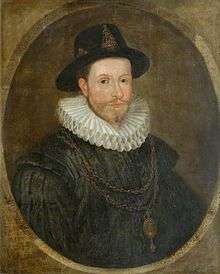George Keith, 5th Earl Marischal
George Keith, 5th Earl Marischal (c. 1553–1623) was a Scottish nobleman and Earl Marischal. He succeeded as earl on 7 October 1581, upon the death of his grandfather, William Keith, 4th Earl Marischal.

George Keith was the son of William Keith, Master of Marischal and his wife Elizabeth Hay. Few details of his education are known, but in 1573 he went to Paris to study horsemanship, and during his travels lodged with Theodore Beza in Geneva where his younger brother William was killed by Spanish bandits. He returned to Scotland in 1580 when James VI made a northern progress and held a meeting of the Privy Council of Scotland at Dunnotar Castle on 18 June 1580. In October he was made a Gentleman of the King's Bedchamber.[1]
Described as one of the most important and powerful men of his day in Scotland, he was sent as ambassador to Denmark in June 1589 to negotiate the marriage of King James VI of Scotland to Anne of Denmark. His companions were Andrew Keith, Lord Dingwall, James Scrimgeour Constable of Dundee, John Skene, William Fowler, and George Young.[2] The English ambassador in Scotland, William Asheby, wrote that the Earl would given £1,500 sterling from the English subsidy money for his expenses, and a payment of £10,000 Scots was recorded in an account of the subsidy kept by the Chancellor, John Maitland of Thirlestane. The Master of Gray thought Queen Elizabeth would be displeased by the use of her money for this.[3]
He took part in a wedding ceremony at Kronborg on 20 August 1589 which involved him sitting on Anne of Denmark's bed as a proxy for the king.[4] Keith bought a jewel to give to the queen during the ceremony, his credit assisted by Fredeerick Lyall, a Scottish merchant in Helsingør.[5] There was discussion whether the queen's dowry money should be brought home untouched to Scotland, or whether he and his kinsmen, Lord Dingwall and William Keith of Delny, should be recompensed.[6] The Earl and Maitland disagreed over this and other issues.[7]
On 14 April 1592 his wife Margaret, Countess Marischal, welcomed Captain Thomas Kerr or Carr and his brothers and friends to Dunnotar Castle, and they took command of the castle. At first it was thought they were agents of the Earl of Huntly and the lairds of Aberdeenshire began to assemble to recover the castle, but soon it was reported that the countess herself had invite Kerr to eject the earl's servants who had displeased her.[8]
He founded the Marischal College in Aberdeen in 1593 and was Royal commissioner to the Parliament of Scotland in 1609.
He rebuilt his family seat of Keith Marischal in 1589, and also constructed new buildings at Dunnottar Castle. He also built new harbours at Peterhead and Stonehaven, using Norwegian timber and employing the mason James Mackene. The earl had a fishing boat and house at Footdee in Aberdeen, as well as a townhouse between the Tolbooth and the Quay.[9] Other houses included "Gubriell" near Dunfermline.[10] In 1595 he bought a cargo of Norwegian timber for building Peterhead harbour from Thomas Ogilvy, with his ship, the Bonadventure. However, the ship did not belong to Ogilvy.[11]
He died in 1623.
Marriages and children
He married firstly (c. Feb. 1581) Margaret, the daughter of Alexander Home, 5th Lord Home and Margaret Ker, a daughter of Sir Walter Ker of Cessford. Their children imcluded:
- William Keith, 6th Earl Marischal.
- Anne Keith who married William Douglas, 7th Earl of Morton.
- Margaret Keith who married Sir Robert Arbuthnott, of that ilk but had no issue.
- Mary Keith married John Campbell of Cawdor
He married secondly (c. 1599), Margaret Ogilvy daughter of James Ogilvy, 5th Lord Ogilvy of Airlie. Their children included:
- James Keith of Benholm who had no male issue.
- John Keith who had no issue.
References
- Miles Kerr-Peterson, A Protestant Lord in James VI's Scotland: George Keith, Fifth Earl Marischal (Boydell, 2019), pp. 23-5.
- Miles Kerr-Peterson, A Protestant Lord in James VI's Scotland: George Keith, Fifth Earl Marischal (Boydell, 2019), pp. 47-9.
- Calendar State Papers Scotland, vol. 10 (Edinburgh, 1936), pp. 88, 94: Miles Kerr-Peterson & Michael Pearce, 'James VI's English Subsidy and Danish Dowry Accounts', Scottish History Society Miscellany XVI (Woodbridge, 2020), p. 27.
- David Chrytraeus, Epistolae (Hanovia, 1614), pp. 696, 711: David Stevenson, Scotland's Last Royal Wedding (Edinburgh, 1997), pp. 22-3, 85-6: Miles Kerr-Peterson, A Protestant Lord in James VI's Scotland: George Keith, Fifth Earl Marischal (Boydell, 2019), p. 50.
- Miles Kerr-Peterson & Michael Pearce, 'James VI's English Subsidy and Danish Dowry Accounts', Scottish History Society Miscellany XVI (Woodbridge, 2020), p. 36.
- Calendar State Papers Scotland, vol. 10 (Edinburgh, 1936), pp. 221-2: Robert Vans-Agnew, Correspondence of Sir Patrick Waus (Edinburgh, 1887), p. 447.
- Miles Kerr-Peterson, A Protestant Lord in James VI's Scotland: George Keith, Fifth Earl Marischal (Boydell, 2019), pp. 46, 52.
- Calendar State Papers Scotland: 1589-1593, vol. 10 (Edinburgh, 1936), pp. 668-671: Miles Kerr-Peterson, A Protestant Lord in James VI's Scotland: George Keith, Fifth Earl Marischal (Boydell, 2019), p. 62.
- Miles Kerr-Peterson, A Protestant Lord in James VI's Scotland: George Keith, Fifth Earl Marischal (Boydell, 2019), pp. 152-157.
- Calendar State Papers Scotland, vol. 10 (Edinburgh, 1936), p. 749.
- Register of the Privy Council of Scotland, vol. 5 (Edinburgh, 1882), p. 221.
- A Genealogical History of the Dormant, Abeyant, Forfeited, and Extinct Peerages of the British Empire, Sir Bernard Burke, 1883.
- "Keith, George, fourth Earl Marischal". Oxford Dictionary of National Biography (online ed.). Oxford University Press. doi:10.1093/ref:odnb/15263. (Subscription or UK public library membership required.)
| Parliament of Scotland | ||
|---|---|---|
| Preceded by The Duke of Lennox |
Lord High Commissioner 1609–1617 |
Succeeded by The Marquess of Hamilton |
| Peerage of Scotland | ||
| Preceded by William Keith |
Earl Marischal 1581–1623 |
Succeeded by William Keith |